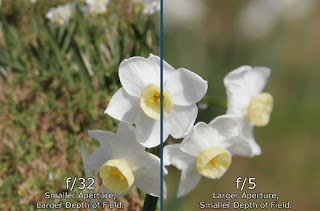Photography:
- Of relating to, or produced by light…as in photosynthesis
- Indicating a photographic process…photolithography
- from Greek phōtōs ~ light
If too much light enters the camera the photo will
be ‘overexposed,’ ‘too bright,’ or ‘blown out.’
If too little light enters the camera the photo
will be ‘underexposed,’ ‘too dark,’ or ‘black.’
With the right amount of light allowed into the camera, results in a photo that is ‘properly
exposed.’
·
How much light enters the camera depends on
two things:
o
The Aperture
o
The Shutter Speed
o …ISO
settings also affect the exposure…but that’s for another day
The
Aperture ~ From
Latin meaning ‘open’
The aperture is the circular mechanism inside your
camera that opens and closes when a picture is taken. You can set the aperture to open wide or to very tight when a
picture is taken…and all degrees in between.
The larger the aperture the more light will enter the camera.
The smaller the aperture the less light will enter the camera.
Your eyes’ pupils are apertures: the pupil gets wider in the dark, to let more light in, and narrower in the light, to lessen the amount of light entering.
The larger the aperture the more light will enter the camera.
The smaller the aperture the less light will enter the camera.
Your eyes’ pupils are apertures: the pupil gets wider in the dark, to let more light in, and narrower in the light, to lessen the amount of light entering.

The settings for the aperture openings (large or small) are called ‘F-stops.’ The confusing thing about the aperture is the larger the opening the smaller the f-stop number.
·
F22 (F-stop 22) translates into a very small
aperture opening and F2 means a very large aperture opening.
Which aperture you choose often depends on the
‘depth of field’ you want.
·
Depth of Field (DOF/dof) refers to how much
of the photo is in focus and how much is out of focus (blurry).
o
A very shallow dof would mean the subject
(the person, horse, building, flower you're photographing) is in focus, but the
background is very blurry.
- § Again, thinking in relation to your eyes’ pupils - when dilated or wide open it lets in a lot of light and becomes difficult to focus and when your pupils are narrow it becomes easier to focus.
o A
very large dof brings everything in the photo in equal focus…from the
foreground to the background.
Soooooo…
If you want a shallow dof (background blurry) you
choose a large aperture opening (ex. F2.8).
And…
If you want a large dof (everything in focus) you
choose a small aperture opeining (ex.f22).






No comments:
Post a Comment